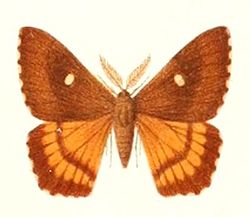| Cercophaninae | |
|---|---|
 | |
| Microdulia mirabilis , male | |
| Scientific classification | |
| Kingdom: | Animalia |
| Phylum: | Arthropoda |
| Class: | Insecta |
| Order: | Lepidoptera |
| Family: | Saturniidae |
| Subfamily: | Cercophaninae |
| Genera | |
See text | |
Cercophaninae is a subfamily of the family Saturniidae, and was, until recently, treated as a separate family, Cercophanidae. [1]
This subfamily contains the following genera: [2]
- Cercophana C. Felder, 1862
- Janiodes Jordan, 1924
- Microdulia Jordan, 1924
- Neocercophana Izquierdo, 1895